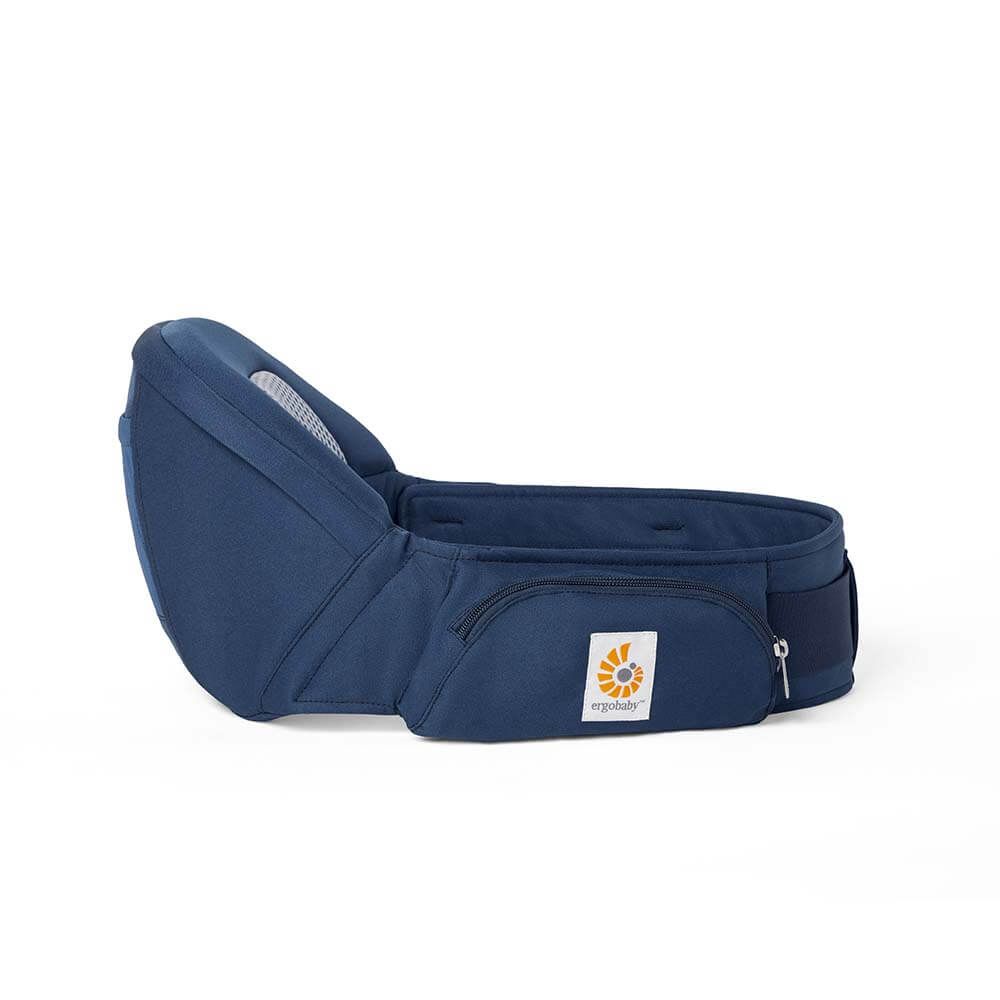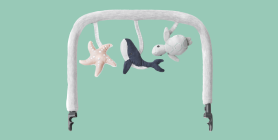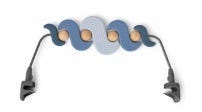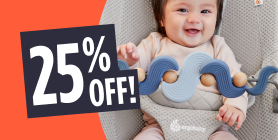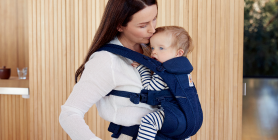Health Professionals
August 30, 2018
When you’re looking for a baby carrier for your newborn, you want one that’s comfortable for you and your baby; one that evenly distributes your baby’s weight and doesn’t put unnecessary pressure on your back and shoulders. But even more importantly, you want an ergonomic baby carrier because it properly and safely supports your little one.
What is an ergonomic baby carrier?
An ergonomic baby carrier supports the natural posture of babies, while encouraging healthy hip development. It should support your baby’s legs up to the backs of his knees, so his entire legs don’t dangle, but he can still freely move his lower legs as he gets a little older. An ergonomic carrier comes with a wide, comfortable base that supports your baby’s weight so more of it is on her bottom rather than her crotch and holds your baby’s hips and legs in a frog leg or M shape. In this ergonomic position, your baby’s bottom is lower than her knees, while her knees and hips are level with one another and her hips are
Health Professionals
March 20, 2018
Pregnancy is an intense period in any woman’s life, filled with surprisingly rich and varied emotions, as well as visions of your future life as a mother. Amidst the joyful prospects of soon being able to welcome your little one, some expectant mothers are concerned that they may develop a postpartum mood disorder or depression. Postpartum depression is among the most disabling disorders for women in their childbearing years and the leading cause of non-obstetric hospitalization among women in the United States, affecting as many as 1 in 5 women. And because it happens during that very period where the new baby is the most vulnerable and sensitive to a mother’s mood and behavior, this depression can have a strong impact on the developing child, as well as the whole family. In this article, we will review the basic understanding of postpartum depression, and uniquely, we will describe the potential direct and indirect contributions of parent-baby skin-to-skin contact and babywearing
Health Professionals
December 13, 2017
Ergobaby's 180 Reversible Stroller reversible design is better for your baby than you may know. The way you use your stroller could very well be shaping your child’s brain development. Neuroscientists have made great strides in the last decade in understanding how babies’ brains develop. It has relevance to all sorts of parenting decisions, including what kind of stroller to buy and how best to use it. Ironically, most parents still have little awareness of that information. There are two particularly important insights that emerge from these discoveries. The first is that brains are developing more rapidly in the first 3 years of life than they ever will again. These are, of course, precisely the years that a child spends in a stroller. The second is that relationships with people have a massive impact on the pathways that form in the brain. The direction that a stroller faces naturally changes the way a baby experiences her relationship with her parent. Human babies are born already
Health Professionals
March 13, 2017
Once she’s born, your baby first learns about scent, touch, sight, hearing, taste and trust —along with many other things—from being right there against you. She came from you. And now that she’s here, skin to skin, also known as Kangaroo Care, is a way to maintain that unique closeness you and baby shared when she was in your womb. When naked baby is put right onto mom’s bare chest, skin to skin, she is usually happier. Remember in the womb, your baby didn’t have to regulate her temperature. So right there next to you helps her stay nice and cozy. In my experience, babies who are allowed more time skin to skin have better weight gain than those who are not. They literally have access to mom’s breast milk whenever they want it. They also don’t have to use their calories to regulate their own temperatures — they use their energy to grow. This means a happier infant with a stable heart and breathing rate. When a mother practices skin to skin, her own stress levels
Health Professionals
January 04, 2012
“Baby carrying strengthens the bond between you and your baby.” This is a statement you often hear from baby carrying advocates, be it experienced mothers, babywearing consultants or midwives. It really only takes one look at a calm secure parent and her or his quiet, relaxed, content and alert baby in a good baby carrier to instinctively sense that this statement is probably quite true.
These are very fundamental questions: Should I give ample physical contact to my baby? Or, should I leave it more or less physically separated from me in the hope that this best fosters independence? For many parents, instincts and intuition are sufficient guidelines for their parenting choices. However, such instincts can be challenged by conflicting views, purported by some experts in the field. Some will argue that giving too much physical contact to a baby will make it clingy and dependent in the long run. One informational resource for such vital decisions comes from the field of science, in this
Health Professionals
November 02, 2011
One of the salient features of a well-designed baby carrier is that it keeps the carried baby in a correct ergonomic position. The obvious question which follows from such a statement is what constitutes a correct ergonomic carrying position for a newborn baby? A minimum requirement for an ergonomically correct position is that it should ideally promote a healthy development of the baby’s hips and spine. One of the conditions which pediatricians will normally investigate in a newborn child and in subsequent well-baby check-ups is that of developmental dysplasia of the hips (DDH). Hip Dysplasia definition and occurrence DDH is a disorder related to what is commonly known as the hip joint. The hip joint is where the head of the thigh bone (the femur) meets with the hip socket (the acetabulum). Hip dysplasia is diagnosed when there is either a complete or partial dislocation of the head of the thigh bone, so it no longer fits snugly and firmly into the hip socket; or instability, as
Health Professionals
October 06, 2011
There certainly is no dearth of websites and organizations which offer information on parenting and baby development. However, the Attachment Parenting International (API) organization is one of the relatively few organizations which offer a coherent, comprehensive and practical approach to raising children, based on a very specific set of values. And what is more important, the advices that API puts forth, are based on solid scientific insights, developed over the past some 60 years. The fundamental ideas of API stem from the pioneering work of Sir John Bowlby who formulated the concept of Attachment Theory. His work has subsequently inspired hundreds of researchers across the globe. They have strived to refine the concepts to make them even more applicable for parents and to assist early care workers in their efforts to help babies and children who have not had initially good circumstances. In this article we will take a look at the founder of Attachment Theory, Sir John Bowlby – his
Health Professionals
September 01, 2011
There certainly is no dearth of websites and organizations which offer information on parenting and baby development. However, the Attachment Parenting International (API) organization is one of the relatively few organizations which offer a coherent, comprehensive and practical approach to raising children, based on a very specific set of values. And what is more important, the advices that API puts forth, are based on solid scientific insights, developed over the past some 60 years.
The fundamental ideas of API stem from the pioneering work of Sir John Bowlby who formulated the concept of Attachment Theory. His work has subsequently inspired hundreds of researchers across the globe. They have strived to refine the concepts to make them even more applicable for parents and to assist early care workers in their efforts to help babies and children who have not had initially good circumstances.
In this article we will take a look at the founder of Attachment Theory, Sir John Bowlby – his
Health Professionals
August 01, 2011
For most parents, infant massage is a rewarding activity in its own right. Just consider the sheer enjoyment of touching and gently rubbing and stroking this little marvel of nature, with its lush, soft and delicately fragrant skin and all its subtle, yet clear signs of appreciation of being massaged. Over and above being a mutually pleasurable activity, research into infant massage over the past decades has established a range of beneficial effects on the infant, and equally important, on the relationship between the mother and her baby. In this article, we will look at some of the effects of infant massage on premature and full-term babies, respectively. These effects include weight gain, sleep organization and mother-baby relationship.
Infant massage for premature infants
Extensive research has been conducted on the effects of infant massage on stable pre-term infants. Certainly, premature birth is no trivial matter. At present approximately 14% of infants in the United States are
Health Professionals
July 01, 2011
One of the major sources of frustration and even guilt in early motherhood is breastfeeding. Yes, for some mothers breastfeeding runs utterly smoothly, but for others, breastfeeding challenges become a partially painful and uneven ordeal. The range of complaints includes cracks and fissures in the nipples, sore breasts, infections, fungi, concerns with having enough milk, and feelings of having to feed too frequently and thus becoming a milk-producing machine. These conditions make breastfeeding less of the pleasant bonding activity which most mothers envision for their unborn child. So, what can help these mothers? Perhaps a few breastfeeding tips and education.
First Recourse: Mastering the Basics
The first recourse or breastfeeding tip is naturally to make sure that the basics are in place. There is plenty of literature out there, which an expectant woman can read at her own leisure. The website of La Leche League is a very good on-line source of information. La Leche League has





